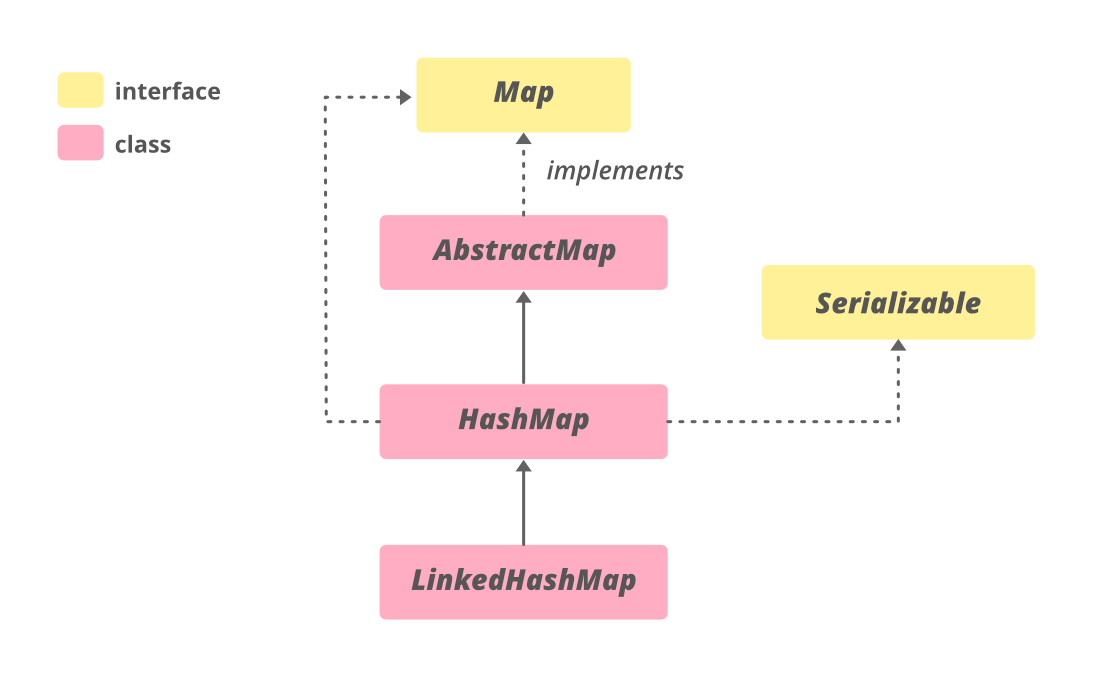Traverse Through a HashMap in Java
Last Updated :
19 Jul, 2022
HashMap stores the data in (Key, Value) pairs, and you can access them by an index of another type. HashMap class implements Map interface which allows us to store key. hashMap is a part of the java collections framework been up since Java 1.2. It internally uses hashing technique which is pretty fast.

Syntax:
public class HashMap<K,V>
extends AbstractMap<K,V>
implements Map<K,V>, Clonnable, Serial
Different Ways of Traversal
We can iterate over mapping that is key and value pairs a was listed below that are later described as follows:
Methods:
- Using an Iterator
- Using enhanced for Loop (for-each loop)
- Using forEach() Method
Method 1: Using an Iterator
Iterator is an interface in java.util package which is used to iterate through a collection. As such there is nothing special to discuss iterators so do we will be proposing out methods of Iterator interface been used to traverse over HashMap.
- hm.entrySet() is used to retrieve all the key-value pairs called Map.Entries and stores internally into a set.
- hm.entrySet().iterator() returns an iterator that acts as a cursor and points at the first element of the set and moves on till the end.
- hmIterator.hasNext() checks for the next element in the set and returns a boolean
- hmIterator.next() returns the next element(Map.Entry) from the set.
- mapElement.getKey() returns the key of the associated Map.Entry
- mapElement.getValue() return the value of the associated Map.Entry
Example:
Java
import java.util.*;
class GFG {
public static void main(String[] args)
{
HashMap<String, Integer> hm
= new HashMap<String, Integer>();
hm.put("GeeksforGeeks", 54);
hm.put("A computer portal", 80);
hm.put("For geeks", 82);
System.out.println("Created hashmap is" + hm);
Iterator hmIterator = hm.entrySet().iterator();
System.out.println(
"HashMap after adding bonus marks:");
while (hmIterator.hasNext()) {
Map.Entry mapElement
= (Map.Entry)hmIterator.next();
int marks = ((int)mapElement.getValue() + 10);
System.out.println(mapElement.getKey() + " : "
+ marks);
}
}
}
|
Output
Created hashmap is{GeeksforGeeks=54, A computer portal=80, For geeks=82}
HashMap after adding bonus marks:
GeeksforGeeks : 64
A computer portal : 90
For geeks : 92
Method 2: Using for-each Loop
Example:
Java
import java.util.*;
class GFG {
public static void main(String[] args)
{
HashMap<String, Integer> hm
= new HashMap<String, Integer>();
hm.put("GeeksforGeeks", 54);
hm.put("A computer portal", 80);
hm.put("For geeks", 82);
System.out.println("Created hashmap is" + hm);
System.out.println(
"HashMap after adding bonus marks:");
for (Map.Entry<String,Integer> mapElement : hm.entrySet()) {
String key = mapElement.getKey();
int value = (mapElement.getValue() + 10);
System.out.println(key + " : " + value);
}
}
}
|
Output:
Created hashmap is{GeeksforGeeks=54, A computer portal=80, For geeks=82}
HashMap after adding bonus marks:
GeeksforGeeks : 64
A computer portal : 90
For geeks : 92
Method 3: Using forEach() method
forEach() is a method of HashMap that is introduced in java 8. It is used to iterate through the hashmap and also reduces the number of lines of code as proposed below as follows:
Example:
Java
import java.util.*;
class GFG {
public static void main(String[] args)
{
HashMap<String, Integer> hm
= new HashMap<String, Integer>();
hm.put("GeeksforGeeks", 54);
hm.put("A computer portal", 80);
hm.put("For geeks", 82);
System.out.println("Created hashmap is" + hm);
System.out.println(
"HashMap after adding bonus marks:");
hm.forEach((k, v)
-> System.out.println(k + " : "
+ (v + 10)));
}
}
|
Output:
Created hashmap is{GeeksforGeeks=54, A computer portal=80, For geeks=82}
HashMap after adding bonus marks:
GeeksforGeeks : 64
A computer portal : 90
For geeks : 92
Like Article
Suggest improvement
Share your thoughts in the comments
Please Login to comment...